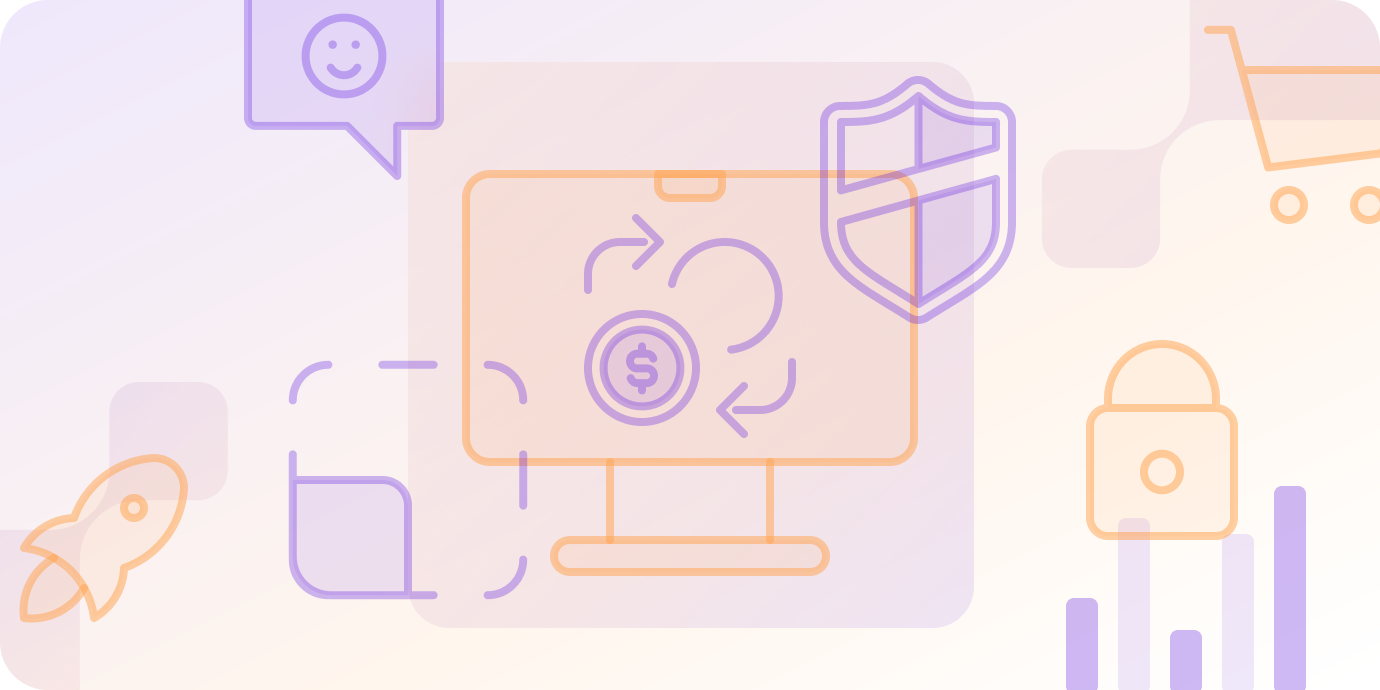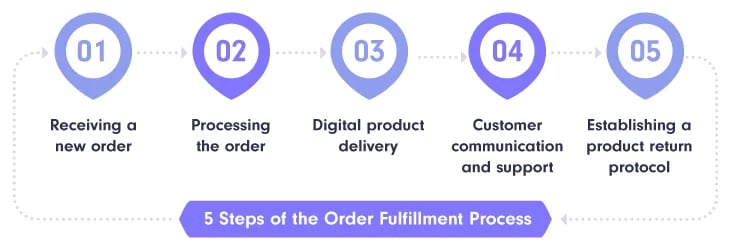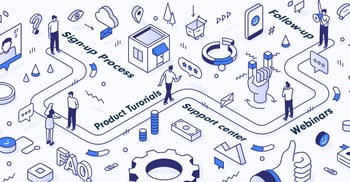Digital Product Fulfillment: SaaS Guide to Optimize Delivery

95% of all purchases are predicted to be made online by 2040. Two important takeaways from this startling number for software and SaaS companies are: online sales are taking over as the primary source of income, and the success of your company depends on how well your digital product fulfillment process works.
Delivering your solutions to clients may appear simple to SaaS developers and digital product firms, but there is a complicated web of procedures going on behind the scenes that have a direct impact on customer retention, happiness, and your bottom line. Digital fulfillment is one of the most important touchpoints in your customer journey, and every aspect of your business must engage with customers and offer value.
This guide will assist you in understanding software fulfillment, recognizing typical obstacles, investigating the most effective implementation techniques, and learning how a Merchant of Record (MoR) solution, such as PayPro Global, can revolutionize your digital delivery procedures for worldwide success.
What is Digital Product Fulfillment?
The complete process of delivering electronic products to customers once they have been purchased is referred to as digital product fulfillment. Digital goods, as opposed to physical ones, can be distributed nearly immediately after payment is confirmed, removing the need for conventional inventory control and delivery operations.
Fulfillment for software, SaaS, and digital content suppliers consists of:
- Confirming purchases
- Making payments
- Delivering goods securely (via account activation, download links, or access credentials)
- Handling recurring billing and subscriptions
- Offering assistance after a purchase
- Managing returns and refunds
In the competitive digital economy, building a strong fulfillment system is crucial for user experience, brand credibility, and long-term growth. It's not just a back-office task.
4 Key Digital Fulfillment Challenges
It’s simple to assume that SaaS fulfillment is a straightforward, simple process because apparently, it does give that impression.
However, in the background, multiple processes take place and challenges start arising. Let’s explore the four most common issues SaaS companies have to deal with.
What seems straightforward on the surface frequently contains intricate backend procedures. Working with a Merchant of Record can help SaaS companies overcome the following four major obstacles:
1. Digital Piracy and Fraud Prevention
Challenge: Unauthorized reproduction and dissemination are made easier by technology that facilitates electronic distribution. Digital goods are susceptible to fraudulent purchasing, illegal sharing, and piracy.
The MoR Solution: Sophisticated fraud prevention measures and strong digital rights management (DRM) systems are implemented by a specialized Merchant of Record such as PayPro Global. Modern fraud detection technology from PayPro helps spot questionable transactions before they are finalized, safeguarding your money and digital assets while lowering chargebacks.
2. Capacity and Scalability Issues
Challenge: Your infrastructure must manage an increase in order volume as your SaaS company expands without sacrificing delivery quality or speed. It may take a significant financial commitment and technological know-how to scale your fulfillment capabilities.
The MoR Solution: PayPro Global’s unique MoR model is scalable, managing millions of transactions globally.
3. Customer Expectations and Support
Challenge: Customers of today demand faultless, immediate digital delivery as well as prompt support in the event of problems. Negative reviews, more demands for refunds, and customer attrition may result from not living up to these expectations.
The MoR Solution: Through various channels and time zones, the Merchant of Record offers comprehensive customer service support, addressing technical delivery concerns, payment issues, and post-purchase inquiries, inclunding handling billing issues.
4. Data Security and Global Compliance
Challenge: Digital companies have to protect consumer data and adhere to intricate local rules like the CCPA, GDPR, and ever-changing tax legislation. Sustaining compliance in several jurisdictions calls for specific expertise and ongoing observation.
The MoR Solution: The MoR takes on the compliance burden as your legal entity, handling tax computations, collections, and remittances worldwide. The software manages all reporting needs and automatically applies the appropriate tax rates based on each customer's region.
eCommerce Partner
Thrive with the industry's most innovative all-in-one SaaS & Digital Goods solution. From high-performing payment and analytics tools to complete tax management, as well as subscription & billing handling, PayPro Global is ready to scale your SaaS.
Sell your SaaS globally with PayPro Global!
The 5 Steps Of The Order Fulfillment Process
Knowing each stage of digital fulfillment makes it easier to identify opportunities to improve customer satisfaction and expedite processes:
Step 1: Receiving a new order
When a customer places an order, the fulfillment process starts. A smooth checkout process is essential since complex procedures can cause customers to abandon their carts. The delivery procedure needs to start immediately as soon as the customer submits the required information and payment details.
Step 2: Processing the order
Following order placement, the system needs to accept payment, confirm all customer information, and turn on fraud detection measures. Overall customer satisfaction is greatly impacted by how quickly and reliably this phase is completed.
Step 3: Digital product delivery
The digital product must be delivered by email attachments, direct downloads, access codes, or account activation when payment has been confirmed. Secure delivery methods are essential, but digital inventory management is not an issue like it is for physical products.
Step 4: Customer communication and support
Brand trust is developed by prompt, transparent communication at every stage. Usage guidelines, shipping alerts, and order confirmations help clients get the most out of their purchases.
Step 5: Establishing a product return protocol
Even with the greatest of intentions, some clients will ask for reimbursements. Maintaining goodwill and adhering to consumer protection regulations requires a streamlined procedure and a transparent, equitable return policy.
Online brands need to make sure they have a solid refund process in place. This alone can destroy your reputation and, in some cases, bring your business to failure.

In-house vs. Merchant of Record Fulfillment: A Comprehensive Comparison
A number of considerations must be made when deciding whether to work with a Merchant of Record or handle fulfillment internally. Let's investigate both possibilities:
In-house Fulfillment
Also known as self-fulfillment, this model entails that the merchant handles the entire online process internally. Generally considered a better option for small businesses, it can be found in larger companies as well.
Advantages:
-
- GreaIncreased control and customisation: Internal fulfillment management gives you direct control over every procedure and permits a great deal of customisation to answer specific company requirements.
- Direct Customer Interaction: Any customer communication is handled directly, which may allow for more individualized support.
Disadvantages:
-
- Time-consuming Implementation: Developing a comprehensive fulfillment system takes resources away from core efforts for product creation and expansion.
- Expensive Infrastructure Requirements: Investing heavily in servers, bandwidth, software development, security protocols, and specialist staff is necessary for in-house solutions.
- Hidden Compliance Costs: Adhering to diverse compliance regulations involves extensive investments in creating systems, ensuring expertise, and monitoring regulation changes.
- Challenges in Scaling: Maintaining performance requires large extra investments when transaction volumes increase or you enter new markets.
- Gap in Compliance Expertise: Most software companies lack the specific knowledge necessary to stay current with the rapidly changing worldwide rules.
Merchant of Record Fulfillment with PayPro Global
Merchant of Record are solutions that provide complete assistance and handle the entire delivery of digital goods as a result of an existing partnership.
Advantages:
-
- Specialized Knowledge: MoRs offer efficiency, security, and dependability that are unmatched by most in-house systems, thanks to their focused knowledge in digital product distribution.
Ready-made Global Infrastructure: Without creating it yourself, you may access an established, tried-and-true infrastructure that manages millions of transactions across multiple regions.
Comprehensive Tax and PCI Compliance Management: MoRs handle tax calculations, collections, and remittance, taking legal responsibility for transactions.
Subscription Lifecycle Management: MoRs offer tools explicitly designed to handle the recurring billing, dunning, renewal, downgrade, upgrade, and free trial processes essential for SaaS companies.
Optimize time and resources: MoRs help direct business and engineering resources away from cross border payments infrastructure and toward product development and expansion.
Decreased Financial Risk: MoRs ensure lower initial expenditures and steady transaction-based pricing scales as your company expands.
- Specialized Knowledge: MoRs offer efficiency, security, and dependability that are unmatched by most in-house systems, thanks to their focused knowledge in digital product distribution.
Disadvantages:
-
- Less Direct Control: Some customization limitations compared to fully proprietary systems.
Integration Requirements: Initial setup requires integration work, though PayPro offers multiple integration options including API, plugins, and hosted pages.
Sharing Customer Relationships: Customer payment information resides with the MoR, though PayPro Global provides comprehensive data access and reporting.
- Less Direct Control: Some customization limitations compared to fully proprietary systems.
How PayPro Global's Unified MoR Solution Transforms Digital Fulfillment
Unlike fragmented solutions that address only parts of the fulfillment process, PayPro Global provides an all-in-one eCommerce solution specifically designed for software, SaaS, and digital goods companies.
Purpose-Built for Digital Product Seller
PayPro Global's platform delivers:
Global SaaS Sales Tax Management:
- Automatic tax calculation for 200+ jurisdictions
- Tax collection and remittance handling
- Compliance with digital services tax requirements
- Continuous regulatory monitoring and updates
Comprehensive Global Payment Processing:
- 70+ payment methods across global markets
- Intelligent routing for maximum approval rates
- Multi-currency support (140+ currencies)
- Sophisticated fraud prevention
- Smooth payment gateway integration
- PCI compliance
- Flexible recurring billing models (monthly, annual, usage-based)
- Automated renewals and dunning processes
- Self-service customer portal for plan changes
- Churn prevention and recovery tools
- Revenue recognition and reporting
- Localized checkouts
- Regional payment method optimization
- Currency conversion and display
- Compliance with local consumer protection laws
- Multi-channel support (email, chat, phone)
- Global coverage across time zones
- Resolution of payment and access issues
- Chargeback management and dispute handling
Get in touch with us to investigate our strengths and how they may fit your needs in obtaining a unified eCommerce payment solution.
eCommerce Partner
Thrive with the industry's most innovative all-in-one SaaS & Digital Goods solution. From high-performing payment and analytics tools to complete tax management, as well as subscription & billing handling, PayPro Global is ready to scale your SaaS.
Sell your SaaS globally with PayPro Global!
Get in touch with us to investigate our strengths and how they ma
Conclusion
Although digital product fulfillment may appear simple, it takes advanced technologies and specialized knowledge to manage the entire process efficiently, from checkout to delivery, subscription management, and continuing support. Working with a Merchant of Record like PayPro Global gives software and SaaS companies that are growth-oriented the cross border payments infrastructure, PCI compliance management, recurring billing and customer support they need to provide great experiences while lowering expenses and risks.
Today's customers demand continuous assistance and perfect, immediate digital delivery. In order to meet these expectations, a unified strategy that offers visibility and optimization throughout the whole client lifecycle must replace fragmented systems.
Book a call with PayPro Global today to discover how our all-in-one Merchant of Record solution can simplify your operations, ensure global compliance, and accelerate your growth.
FAQ
What is digital product fulfillment for a SaaS company?
It's the entire post-purchase delivery process for SaaS, software and digital goodsgadgets. This includes recurring billing management, secure access distribution, payment confirmation, and support for SaaS.
What are the main challenges SaaS businesses face with digital fulfillment?
The main obstacles include worldwide data security and compliance (such as GDPR and tax laws), growing infrastructure, high customer expectations for delivery and support, and digital piracy and fraud.
Should my SaaS company handle digital fulfillment in-house or use a Merchant of Record?
Although in-house fulfillment offers control, it requires a lot of resources for scale, infrastructure, and compliance. A Merchant of Record (MoR) frees you up to concentrate on your product by offering knowledge, worldwide infrastructure, and compliance.
How does using a Merchant of Record like PayPro Global improve customer satisfaction with fulfillment?
MoR like PayPro Global meets high client expectations and fosters confidence by guaranteeing prompt, secure product delivery and providing thorough customer support for payment or access concerns.
Ioana Grigorescu
Ioana Grigorescu is PayPro Global's Content Manager, focused on creating strategic writing pieces for SaaS, B2B, and technology companies. With a background that combines Languages and Translation Studies with Political Sciences, she's skilled in analyzing, creating, and communicating impactful content. She excels at developing content strategies, producing diverse marketing materials, and ensuring content effectiveness. Beyond her work, she enjoys exploring design with Figma.
-
1.Explore PayPro Global's Solutions: See how our platform can help you streamline your payment processing and boost revenue.
-
2.Get a Free Consultation: Discuss your specific needs with our experts and discover how we can tailor a solution for you.
-
3.Download our Free Resources: Access valuable guides, checklists, and templates to optimize your online sales.
-
4.Become a Partner: Expand your business by offering PayPro Global's solutions to your clients.
- For SaaS to succeed, digital product fulfillment—which includes safe delivery, subscription management, and after-sale support—is essential.
- A Merchant of Record (MoR) can help solve issues including fraud, scale, customer expectations, and global compliance.
- PayPro Global provides a comprehensive MoR solution that streamlines processes and guarantees worldwide compliance, maximizing digital fulfillment.
Get the latest news



